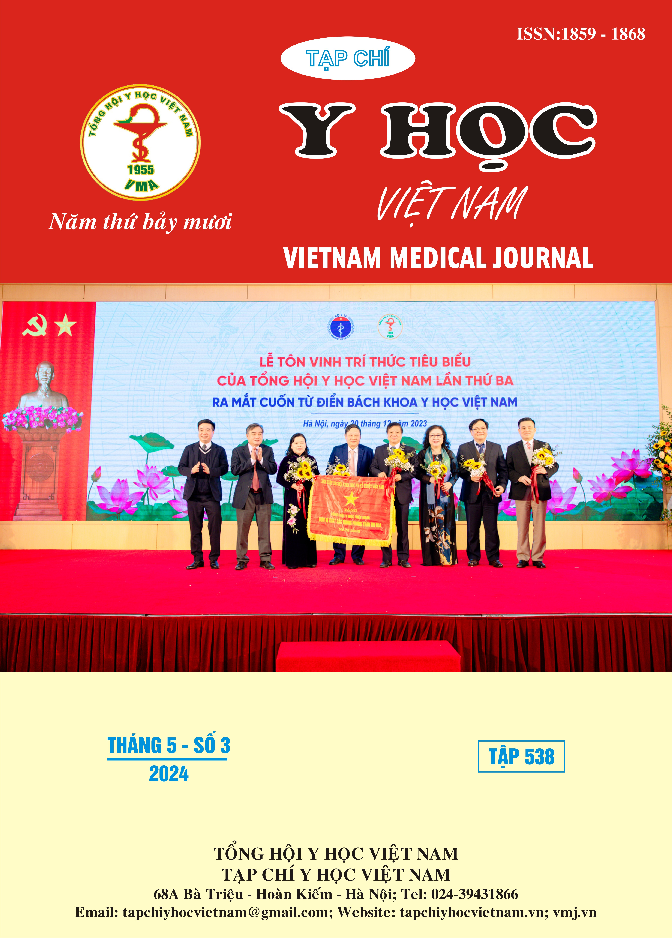RESEARCH THE INCIDENCE OF INSOMNIA AND SOME RISK FACTORS RELATING TO INSOMNIA IN ISCHEMIC STROKE PATIENTS
Main Article Content
Abstract
Objective: To research the incidence of insomnia and some risk factors relating to insomnia in ischemic stroke patients. Subjects and research methods: Prospective study, cross-sectional description, at the Stroke Department, Medical Military 103 Hospital, from June 2023 to January 2024. Results: Diabetes, severe stroke according to NIHSS score, the disability level (according to mRS) and RLS refer to insomnia in ischemic stroke patients. Two risk factors that independently refer to insomnia were Diabetes (OR: 7,014; 95%CI: 1,983-24,809; 0,003), having mRS ≥ 3 (OR: 12,128; 95%CI: 3,195-46,033; p < 0,001) Conclusion: The incidence of insomnia in ischemic stroke patients was 39,02%; Diabetes, disability level post -stroke according to mRS ≥ 3 are mainly independent factors that increased the incidence of insomnia after ischemic stroke
Article Details
Keywords
Insomnia, ischemic stroke, diabetes, disability post – stroke.
References
2. Gupta A., Shukla G., Mohammed A. et al (2017), "Restless legs syndrome, a predictor of subcortical stroke: a prospective study in 346 stroke patients", Sleep Med, 29, pp. 61-67.
3. Joa K.L., Kim W.H., Choi H.Y. et al (2017), "The Effect of Sleep Disturbances on the Functional Recovery of Rehabilitation Inpatients Following Mild and Moderate Stroke", Am J Phys Med Rehabil, 96(10), pp. 734-740.
4. Kim W.H., Jung H.Y., Choi H.Y. et al (2017), "The associations between insomnia and health-related quality of life in rehabilitation units at 1month after stroke", J Psychosom Res, 96, pp. 10-14.
5. David Gunawan Umbas A.S., Ashari Bahar, Muhammad Akbar, Andi Kurnia Bintang (2021), "Sleep quality in post stroke patient with and without type 2 diabetes mellitus: A comparative study", Sciencedirect, pp.
6. Xu H., Li W., Chen J. et al (2023), "Associations between insomnia and large vessel occlusion acute ischemic stroke: An observational study", Clinics (Sao Paulo), 78, pp. 100297.
7. Glozier N., Moullaali T.J., Sivertsen B. et al (2017), "The Course and Impact of Poststroke Insomnia in Stroke Survivors Aged 18 to 65 Years: Results from the Psychosocial Outcomes In StrokE (POISE) Study ", Cerebrovasc Dis Extra, 7(1), pp. 9-20.
8. Venkateshiah S.B., Ioachimescu O.C. (2015), "Restless legs syndrome", Crit Care Clin, 31(3), pp. 459-72.
9. Sechi G., Agnetti V., Galistu P. et al (2008), "Restless legs syndrome and periodic limb movements after ischemic stroke in the right lenticulostriate region", Parkinsonism Relat Disord, 14(2), pp. 157-60.
10. Yildiz D., Kahvecioglu S., Buyukkoyuncu N. et al (2016), "Restless-legs syndrome and insomnia in hemodialysis patients", Ren Fail, 38(2), pp. 194-7.


